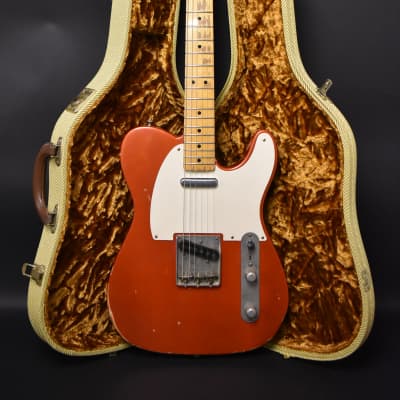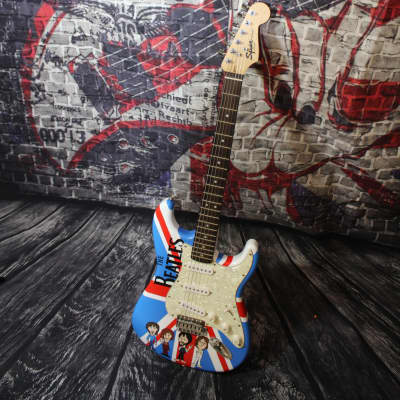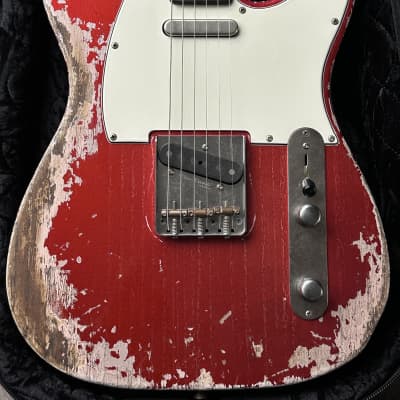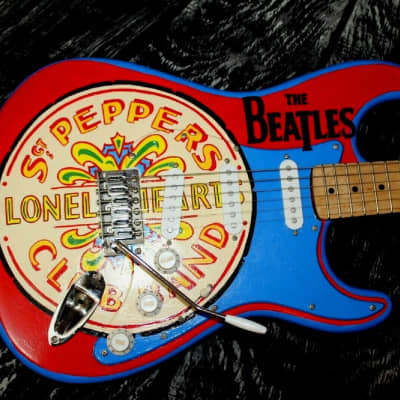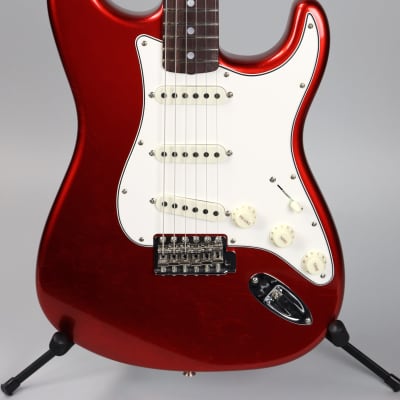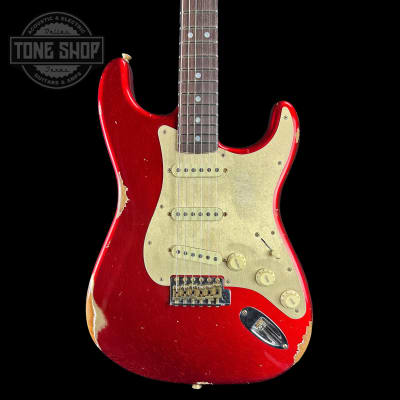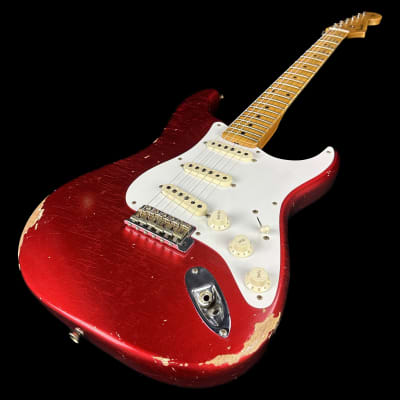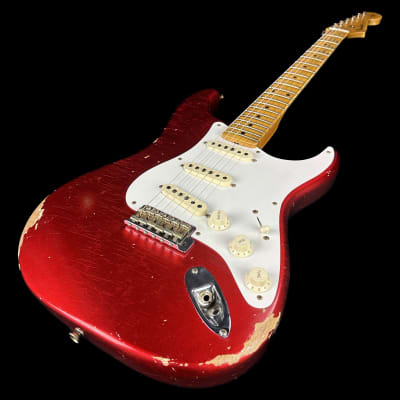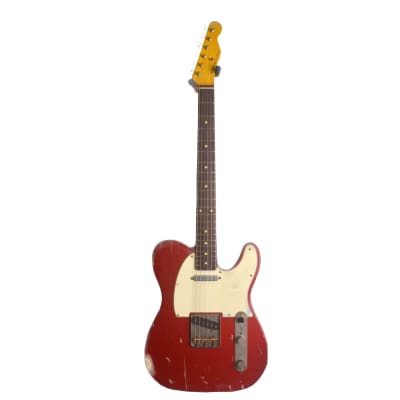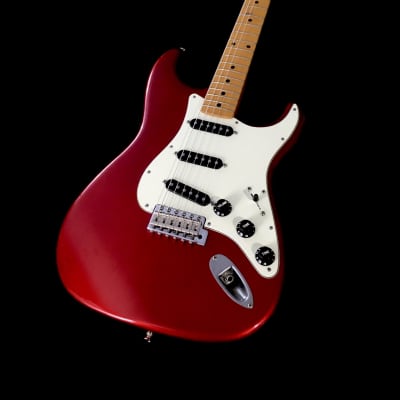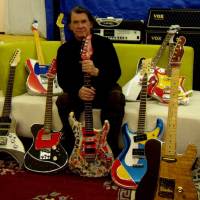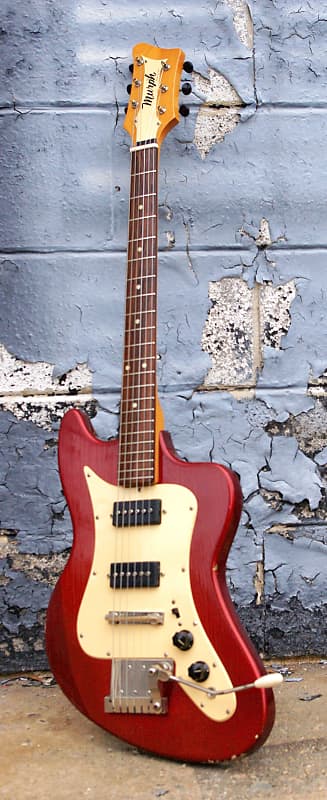

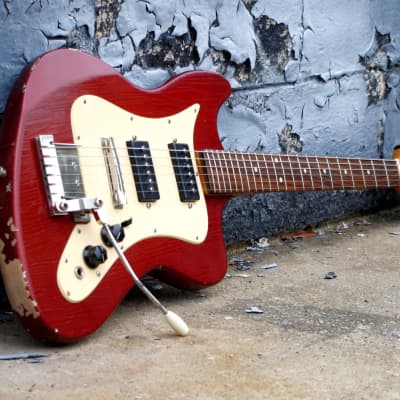
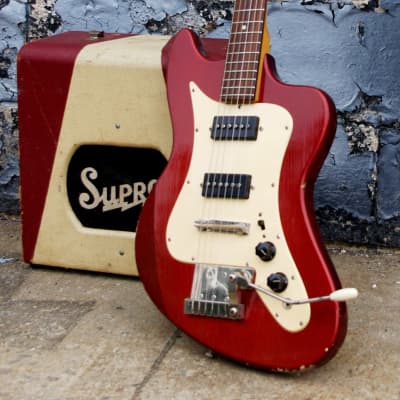
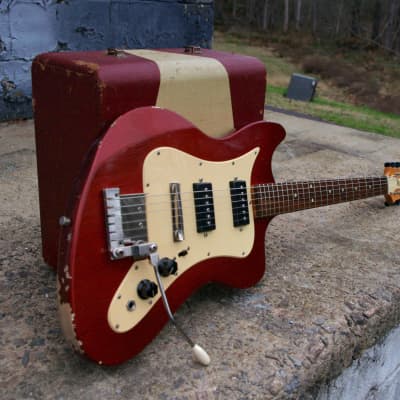
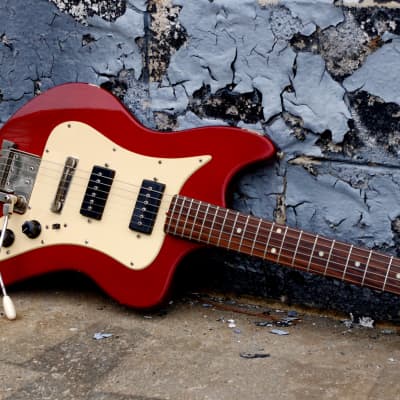
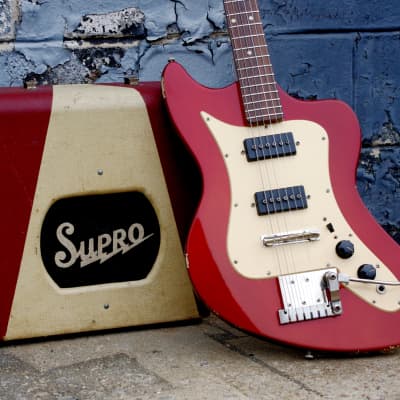
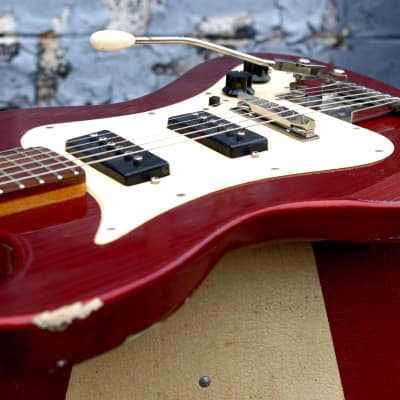
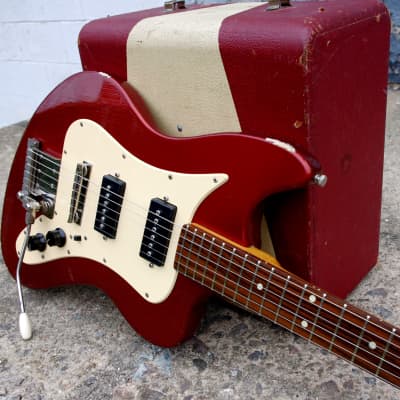
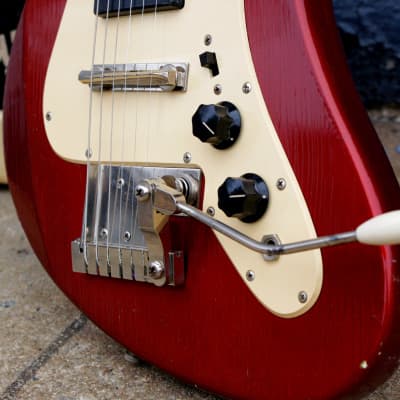
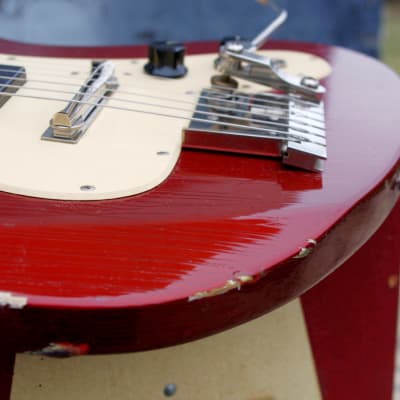
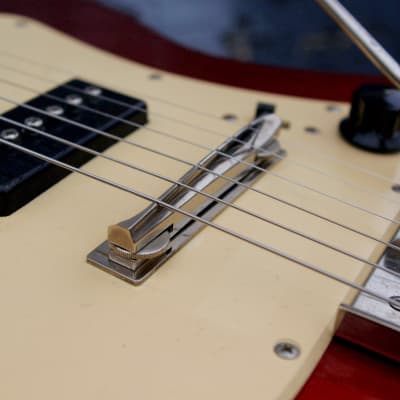
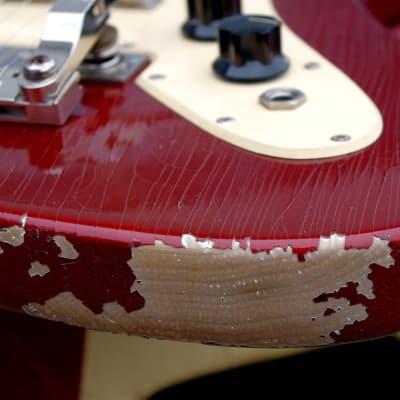
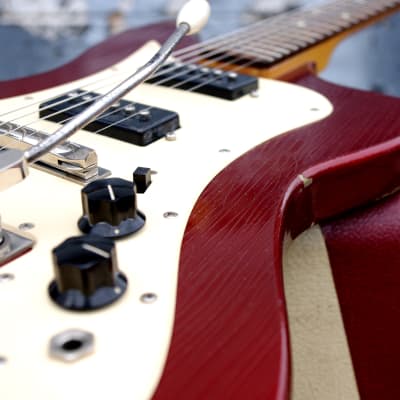
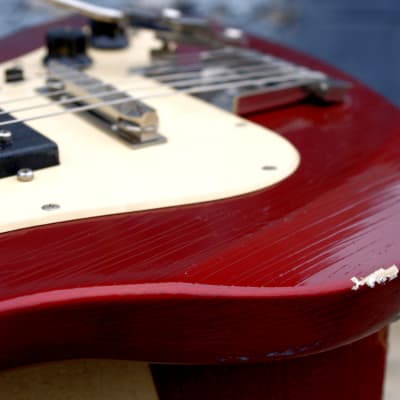
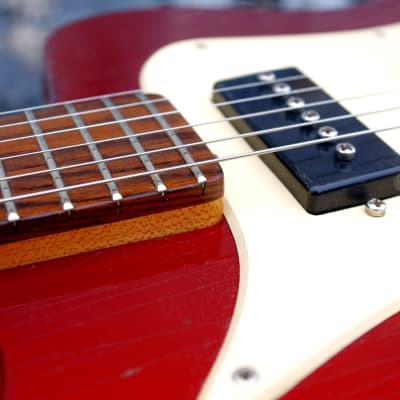
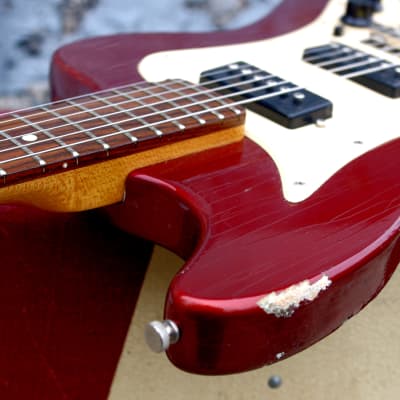
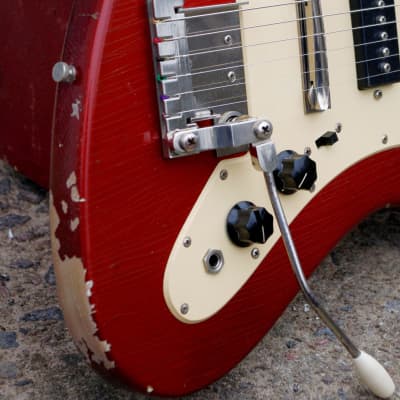
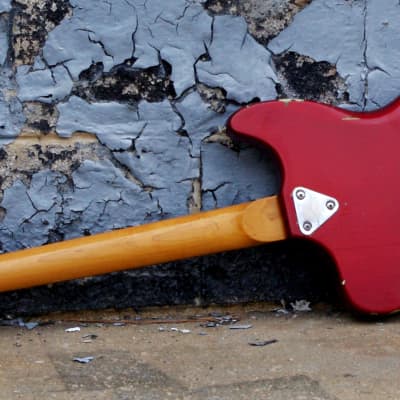
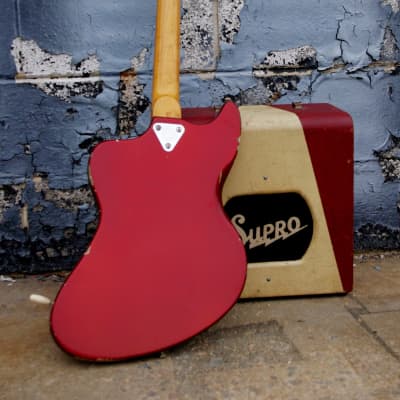
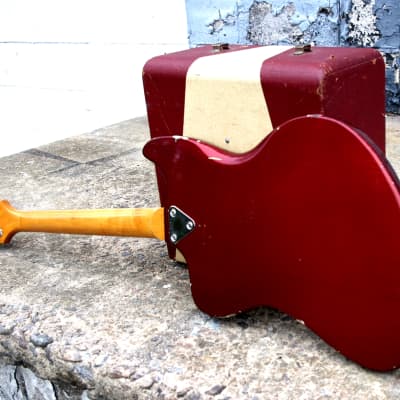
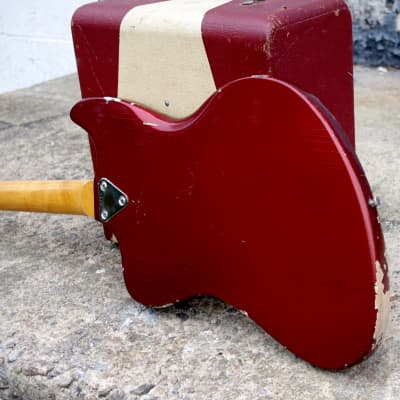
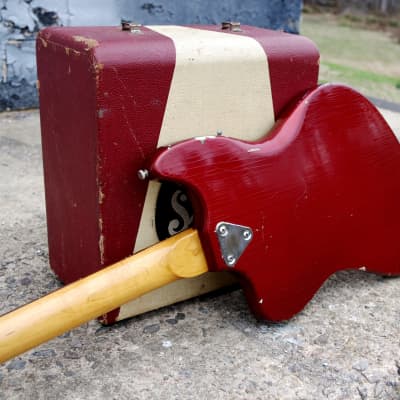
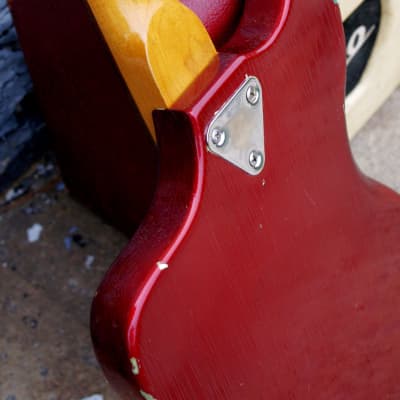
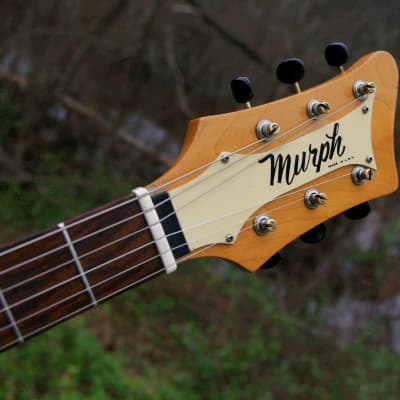
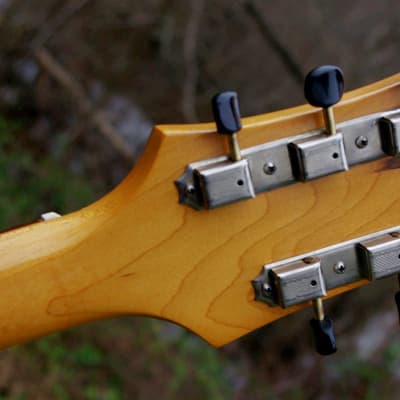
MURPH
SQUIRE II-T
SN: 6741
CREATED BY
Thomas ‘Pat’ Murphy
July 1920 - November 2009
"THE KING OF MURPH-SURF"
EXTREMELY RARE!
WHY BUY THIS GUITAR?
1. It is ultra-rare. A true collector piece.
2. It is an excellent example of guitars Made in the USA in the 1960’s by small shops (usually one man).
3. Excellent example of “offset” American guitars.
4. Sounds great. Real tone coming from “aged” poplar wood body and hard rock maple neck.
5. Plays great. Excellent stage guitar.
6. Has “cool” character and attitude.
7. Why buy new “old” when you can buy the real thing? This is a true “relic” collectible guitar.
ABOUT MURPH GUITARS:
Pat Murphy was not a guitar maker,
he was a GUITAR CREATOR.
The difference between a guitar maker and a guitar creator cannot really be measured. It's like comparing a draftsman to an artist. A guitar maker puts his skill into a functioning musical instrument that makes sounds whereas a guitar creator puts his soul into a piece of art that makes music.
Without a doubt, Pat Murphy, the "KING OF MURPH SURF" captured the essence of a lifestyle when he puts his hands to the wood and metal and turned them into the classic "MURPH" guitar.
Here’s a recent article found online that tells you more about these RARE GUITARS:
Classic Instruments-1965 Murph Squire
11-T
By: Michael Wright, The Different
StrummerPosted On: 1/20/2010
We
live in a golden age, with an incredible selection of guitars available in
virtually any price range.
But if there ever was another golden age, the 1960s are in line for the
nomination. While the across-the-board quality may not have been as good as
it is now, the variety of brands and designs had never been exceeded until
today. To demonstrate, witness one of the more obscure guitars of the
Swinging '60s - this circa 1965 Murph Squire 11-T.
The causes of the '60s guitar boom are pretty well-known. Following World War
II, hundreds of thousands of young American GIs returned home with one thing
on their minds. The result was the fabled post-war Baby Boom. Fast forward to
the 1960s, and the first wave of Boomers is hitting its teenage years - a
huge wave of children, the first raised in the glow of modern mass media.
These kids liked music - first folk, and then, especially after the Beatles,
rock and roll. And both required guitars. Lots and lots of guitars.
By '65, it seemed that there was no end to the potential of the guitar
market. Mass manufacturers like Harmony and Kay could sell every guitar they
made. A feeding frenzy of corporate takeovers ensued. In 1965, CBS took over
Fender. And along the periphery, many smaller guitar hopefuls sprang up, from
Alamo to Kapa to La Baye to Micro-Frets to Wurlitzer. To Murph.
Murph guitars were the brainchild of one of those GIs returning from war in
the Pacific, a Navy pilot named Patrick Murphy. Born in Springfield,
Illinois, in 1920 and brought up in Detroit, Murphy settled in California
after the war and set about raising a family. He was not a musician, but his
children were, and they started one of those family singing groups that were
so popular in the '60s, in addition to acting in the Los Angeles area.
Murphy's two oldest boys, Mike and Terry, began taking guitar lessons, and
their guitar teacher Jim Gurley (who later became Murph's salesman) came up
with the idea that Murphy should build guitars for them to perform with (and
thereby promote). From this notion did the guitar shown here spring!
Murphy began designing guitars (with help from his wife, Mary Jane) and
enlisted the help of engineer Rick Geiger who knew something about building
guitars. In February 1965, they opened Murphy Music Industries in a small
factory located at 1817 First Street in San Fernando. Murphy and Geiger
obtained mostly used machinery to set up shop. Murphy's first choice for a
brand name was York, but that name was already taken by a Michigan horn
manufacturer, so he settled on Murph. Geiger left the company before
production could commence, so Murphy carried on with the help of family
members. At its peak, Murph had 22 employees.
Murph guitars were built of three-piece poplar with three-piece Eastern hard
rock maple necks. Rosewood for fingerboards, bridges, and vibratos were
imported from A.C. Gotz in West Germany. Pickups were single-coils wound by
Murph with plastic covers provided by a local supplier. Finished surfaces
received 10 coats of nitrocellulose lacquer. They were outfitted with Kluson
Deluxe tuners and came in cases built by L.A.'s Victoria Luggage Company.
The principal design employed by Murph was this quasi-Jazzmaster shape used
on the Squire, the name given to Murph's solid body. Two models were offered,
the 1-T with a single bridge pickup, and the 11-T shown here, with a pair of
units. One other solid was the Westerner, basically an 11-T covered in blue,
red, or aqua metal flake naughahyde, reminiscent of the vinyl-covered Höfners
and Hagstroms of the time. A Squire 12-String and Squire Bass were also
available. Lefty versions could be custom-ordered. In addition, there was a
Continental IV hollowbody that employed a single-cutaway, Gibsonish design.
This had one neck pickup and a simple wire trapeze tailpiece. A
double-cutaway Gemini model was made briefly in 6- and 12-string versions,
but it doesn't appear in catalogs and may never have gone into production.
These look remarkably like similar Standel models... standard Murph finishes
were Candy Apple Red, White, Blue, or Sunburst.
The electronics on the Squire 11-T shown here are typical of most early
Murphs. They had one master volume and master tone control. The bridge pickup
was always on; the sliding switch activated the neck pickup! Sometime in mid
'66, Murph changed this arrangement to four knobs, volume and tone for each
pickup, with a three-way select on the lower horn. A rough dating clue.
Perhaps the most famous Murph was a "heart-shaped" hollowbody
called the Satellite in 6- and 12-string versions. These were conceived by
the salesman Gurley in late 1966 and featured a three-way pickup selector.
The one "catseye" soundhole looks suspiciously Kawai, and it
wouldn't come as a surprise to learn that these bodies were indeed
Japanese-made. In late '66 or early '67, Murph introduced some prototype
3/4-scale Baby Murph variants of the Satellite, but they never entered
production.
A number of other curious instruments were made by Murph in small quantities.
In '66, Sears contracted for some Silvertones, but only purchased 25, so
somewhere out there may be several of those. Murph also produced another 25
guitars for the record-player manufacturer Rheem Califone bearing the
Califone brand. These had slightly different features, including a large
spatula headstock shape and angled pickups. In January of '67, at least one
prototype amp-in-case Murph was built. The only known professional act to
play Murphs was The Good Time Singers.
Murphy took his Murph guitars to the '66 NAMM show, but didn't cop many
orders. When he got back, he was threatened by a lawsuit from another,
unidentified guitar manufacturer for patent infringement. Between the high
cost of running the company and the threat of protracted legal wrangling,
Murph guitars went under in March or April of '67.
Murph guitars were well-made and fare nicely when compared to many other
brands in the mid-quality range between Gibson and Harmony. Estimates are
that only about 1,200 Murph guitars were produced between 1965 and early '67.
Around 950 or so of those were Squires, making the remaining models
especially rare. (Copyright protection held by owner/writer/publisher.)
THIS GUITAR:
As best I can determine, this is pre-1966 piece because it only has two knobs. It is fully functional.
The color is faded “nitro” candy apple red. THIS IS THE BEST VINTAGE LOOKING FINISH I have seen in a long time. The finish checking is widespread and uniform but not cracked.
The overall condition of the guitar is good (same for case). Lots of finish checking and scruff marks. Just from playing around. There is oxidation on the trem arm metal.
Look at the shape of this guitar. It is an artifact of the 1960's in California with emphasis on the "surf" genre that was quickly developing there. It reeks California beach and sun.
I've made this claim before and it continues to be true. Vintage guitars are a great investment, most especially in uncertain economic times like these. But the "gold pieces" are hard to find and expensive to buy. Pieces like this Murph are great alternatives for the beginning collector and the experienced collector. Don't miss this one.
For buyers outside the continental USA, please ask for shipping quote before buying this item. Thank you.
Please remember to read our policies and procedures listed below.
MY TRY IT OUT POLICY.
Understanding the normal hesitation of buying a guitar without first playing it, I want to make sure these guitars make you happy. To accomplish that, I want you to try them for 72 hours (three days). Play them, hold them, walk around with them on your back, sleep with then-whatever it takes for you to make sure these are the ones for you. During that time, you can return them for a full refund of your payment price (but of course they need to be treated well while you have them, as I expect you will) less shipping cost and you must pay the cost to ship it back to us.
If one arrives damaged, please let me know immediately by email. Be sure to hold onto all packing material and the box. I will contact the shipper for an inspection. Remember that this can take up to a couple of weeks but I will rush it along.
Minor problems. If there is a problem with one of the guitars when it arrives, e.g., loose wires etc. then I will work with you to get it repaired by someone in your area.
OTHER POLICIES.
A. Payment Policy: PAYMENT DUE WITHIN 24 HOURS OF PURCHASE.
B. Shipping Policy: I will ship to the continental USA ONLY.
C. Return Policy:
1. Returnable within 3 days of delivery. Items must be returned in original, as-shipped condition with all original packaging and no signs of use. Buyer pays all return shipping costs.
2. Returns of undamaged and unmodified instruments may allowed, with permission of Seller, for a period of up to 14 days following delivering but will be subject to a 20% restocking fee. Items must be returned in original, as-shipped condition with all original packaging and no signs of use. Buyer assumes responsibility for all return shipping costs.
D. Refunds: Buyer receives a full refund in their original payment method less any shipping charges and restocking fees if appropriate.
E. The guarantee:
1. The guitar is in the cosmetic condition as described in this ad. Used guitars will all have signs of use to include dings, dents, scratches, smudges, etc.
2. The guitar is in fully operational condition.
3. Buyer has 72 hrs. to inspect the guitar or have it inspected. Any defects, damage, misrepresentations or other problems must be reported within that time period in writing to the Seller.
4. In the case of damage during shipment, Buyer shall immediately inform seller of such damage and will maintain all original packing materials and box for inspection by the transportation company.
5. If other problems are discovered, Seller will either arrange for repair etc. at a location near the Buyer or request that the Buyer return the guitar to the Seller. Items must be returned in original, as-shipped condition with all original packaging and no signs of use. Buyer assumes responsibility for all return shipping costs.
Seller will correct indicated problems and ship the guitar back to the Buyer within 7-10 days of receiving it.
6. Refund Procedure.
a. In the event that the guitar cannot be repaired or replaced with a similar item from Seller’s inventory, the Seller will provide a full refund in their original payment method less any shipping charges and restocking fees if appropriate.
b. During this 72-hour evaluation period, the Buyer may return the guitar for any reason by notifying Seller and receiving a Return Authorization number. Guitar must be in the same condition as received by the Buyer. Buyer pays cost of shipping guitar back to Seller.
c. Returns may be allowed, with permission of Seller and issuance of RA#, after the 72 hour evaluation period for up to 14 days total but a standard 20% Restocking Fee will be charged for the return. Guitar must be in the same condition as received by the Buyer. Buyer pays cost of shipping guitar back to Seller.
NOTE: I want each Buyer of a guitar from my collection to be pleased and happy with his/her purchase so let me know immediately of any problems with your purchase so that we can work it out. Thanks.
***SHIPPING: WE WILL NOT SHIP THIS GUITAR BY FEDERAL EXPRESS.
Reverb Buyer Protection
Reverb has your back if your item is lost, damaged, or doesn't match its description. Simply report any issues within 7 days and we'll help you get a full refund.Learn more about Reverb Buyer Protection.
| Listed | 6 years ago |
| Condition | Good (Used) Good condition items function properly but may exhibit some wear and tear.Learn more |
| Brand | |
| Model |
|
| Finish |
|
| Categories | |
| Year |
|
| Made In |
|
| Body Type |
|
